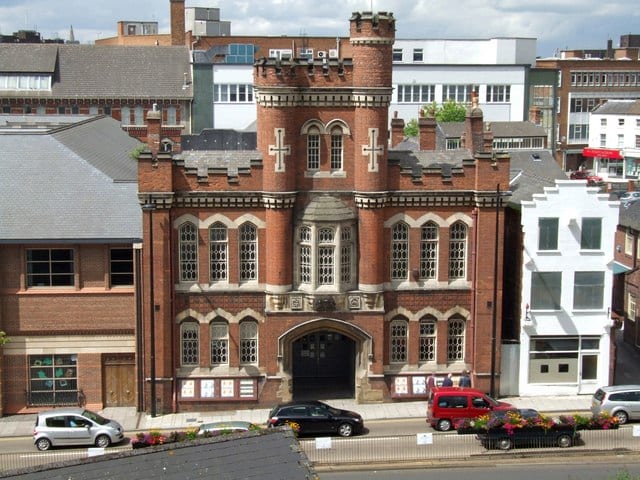The Birth of the Drill Hall
From ‘The Times’ on Monday May 26th, 1890:
“Mr. E. Stanhope (i) opened a new volunteer drill hall at Lincoln on Saturday. The hall has been presented to the Lincoln Volunteers by Mr. Joseph Ruston (ii), a former M.P. for the city, and the total cost is about £10,000. The Drill Hall, erected in 1889-90, from plans by Messrs. Goddard and Son, is of red brick with freestone dressings, and consists of offices, men’s club, orderly room, gymnasium and men’s recreation room, sergeants’ room, magazine, armoury and Morris tube range, band room and caretaker’s quarters.”
“Not only have the Headquarter Companies of the 1st Lincolnshire Volunteer Battalion been provided with a drill hall that embraces every requisite, but the building, with its frontage of 55 ft to Broadgate, is an ornament to the city. The front elevation, of red brick and stone, with Ancaster dressings, presents a military aspect, with its embattlements and watch turret. The gateway is 10 ft wide, and above it the Royal arms are skilfully carved out of stone.
“On entering we find to the right the officers’ room, an apartment 24 ft by 18 ft; to the left, the Adjutant’s room, of the same dimensions, with an office for the Sergeant-Major. The large hall beyond is 140 ft long by 50 ft wide, and a moveable platform will be fitted for meetings and other purposes. The floor has a special feature, suitable for the purposes of drilling. It is formed of wooden blocks 10 in by 2 ½ in by 1 ½ in., laid in pitch, on a solid foundation of concrete and cement. This deadens the sound of a body of men marching and manoeuvring. The armoury is 62 ft by 15 ft, of sufficient capacity to store the whole arms of the battalion if at any time necessary; adjoining this is an armourer’s workshop and a magazine, where several hundred thousand rounds of ammunition could be stored.
“On the north side of the hall is a gymnasium, 50 ft by 30 ft, with lavatory attached, also stores for military clothing and accoutrements, with adjacent closets, and the quarters of the Sergeant-Major.
“Mr Ruston has not forgotten that disastrous times for the poor may again unhappily overtake us, and in connection with the hall he has therefore provided a soup-kitchen, fitted with coppers and every appliance for cooking food.
“Near the entrance gateway a broad and easy staircase gives access to a balcony capable of accommodating 150 people, commanding a view of the hall. Behind this balcony and fronting Broadgate is a large reading and recreation room for the men, and the non-commissioned officers’ recreation room will be comfortably furnished.”
(i) The Right Honorary Edward Stanhope, Secretary of State for War and Member of Parliament for Horncastle.
(ii) Joseph Ruston was elected as a Liberal MP for Lincoln in a by-election in June 1884. He was reelected at the 1885 general election but did not stand again in 1886. He established Ruston, Proctor and Company, agricultural implement makers and engineer, on the site now occupied by Siemens.
Taken from: http://www.lincolndrillhall.com/about-us/the-venue-its-history
